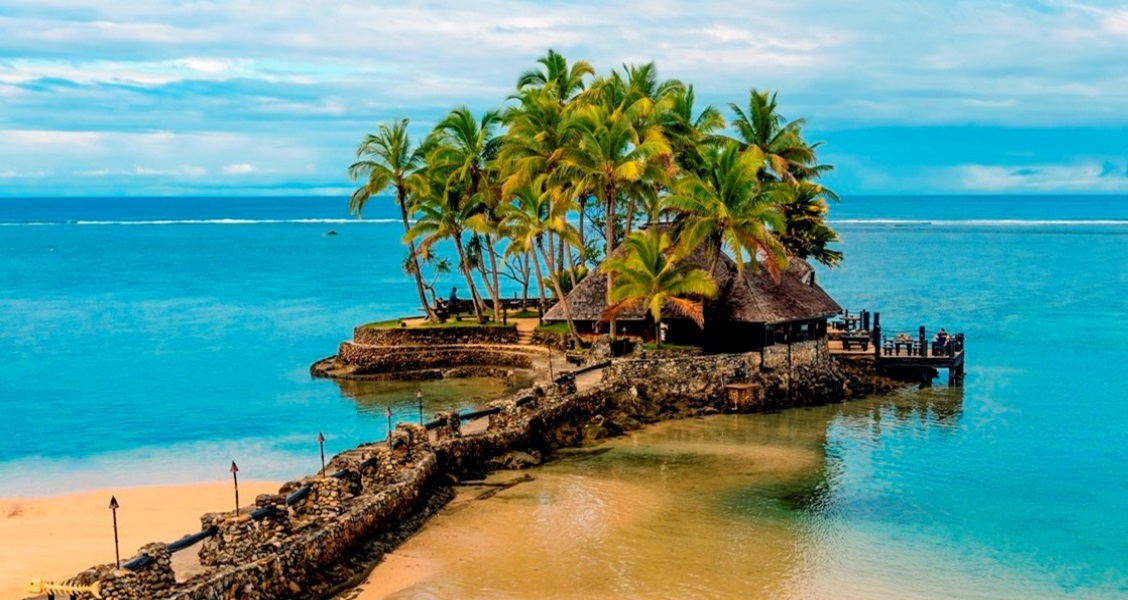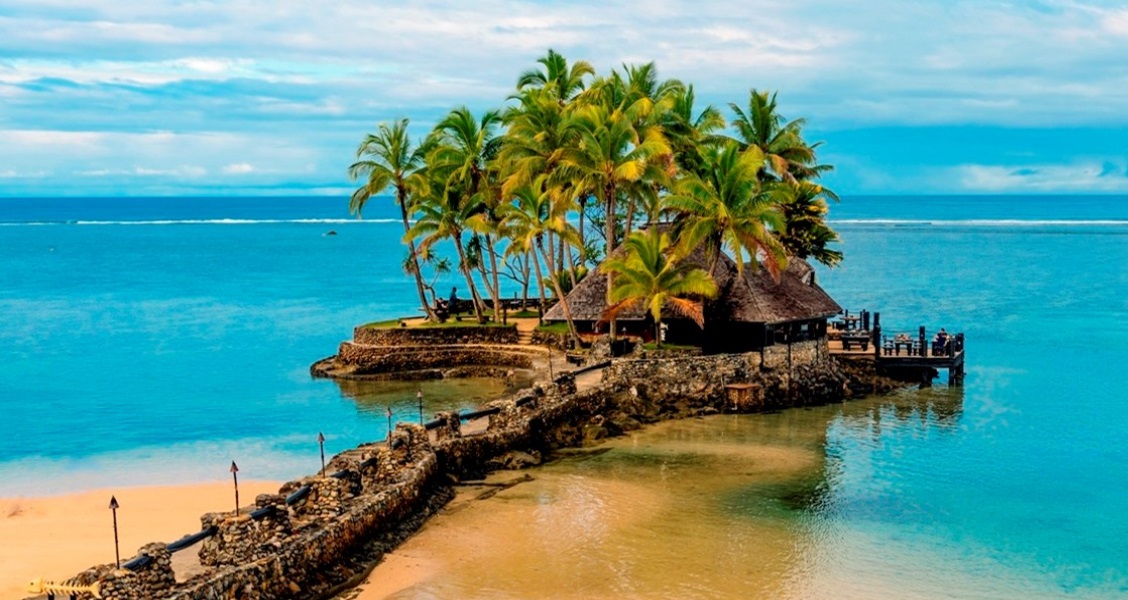
Fiji, a nation comprised of over 300 islands scattered across the azure expanse of the South Pacific, is more than just a postcard-perfect destination; it’s a vibrant tapestry woven with ancient traditions, breathtaking natural beauty, and an infectious spirit of hospitality. From pristine white-sand beaches and crystal-clear turquoise waters teeming with marine life to lush rainforests and volcanic peaks, Fiji offers an unparalleled escape for every kind of traveler. Whether you’re seeking thrilling adventures, serene relaxation, cultural immersion, or a romantic honeymoon, this archipelago of dreams promises an unforgettable experience.
A Glimpse into Fiji’s Rich History
Fiji’s story is as captivating as its landscapes. The islands were first settled by Melanesian peoples around 3,500 years ago, who brought with them advanced seafaring and agricultural techniques. For centuries, Fiji remained relatively isolated, developing its unique cultural identity.

Related Articles about Fiji: An Archipelago of Dreams – Your Ultimate Guide to Paradise:
- Romania: A Tapestry of Legends, Landscapes, and Unforgettable Experiences
- Cairo: A Timeless Tapestry of Ancient Wonders and Modern Marvels
- Kenya: A Tapestry of Wildlife, Culture, and Breathtaking Landscapes
- Barcelona: A Traveler’s Guide to the City of Gaudí and Sunshine
- España: A Tapestry of Sun, Sangria, and Centuries of Stories – Your Ultimate Travel Guide
The arrival of Europeans in the 17th century marked a turning point. Explorers like Abel Tasman and James Cook made brief stops, but it wasn’t until the 19th century that significant European contact began. Missionaries arrived, seeking to convert the Fijian people, and traders established a presence, often in pursuit of sandalwood and beche-de-mer.
The mid-19th century saw the rise of powerful Fijian chiefs and escalating intertribal warfare. This period of instability led to Fiji becoming a British Crown Colony in 1874, a decision driven by both the desire for order and the British interest in the islands’ resources. Under British rule, Fiji experienced significant economic development, particularly in sugar cane cultivation, and the introduction of indentured laborers from India to work the plantations. This influx of Indian population has profoundly shaped Fiji’s modern cultural landscape, creating a unique Indo-Fijian community that coexists with the indigenous Melanesian population.
Fiji gained its independence on October 10, 1970, and has since navigated its own path, embracing democracy while cherishing its rich heritage. Today, the echoes of this history can be found in the welcoming smiles of the Fijian people, the preserved traditions, and the diverse cultural influences that enrich the islands.
Top Attractions: Where Paradise Unfolds
Fiji’s allure lies in its diverse offerings, catering to every whim and fancy. Here are some of its most celebrated attractions:
1. The Mamanuca Islands: This idyllic archipelago of 20 islands, just off the west coast of Viti Levu, is the quintessential Fijian paradise. Famous for their stunning beaches, vibrant coral reefs, and crystal-clear waters, the Mamanucas are a haven for sun-seekers, snorkelers, divers, and surfers. Must-do: Island hopping, snorkeling at the famous "Superman’s Dive" spot, surfing world-class breaks like Cloudbreak (for experienced surfers), and simply soaking up the sun on postcard-perfect shores. Popular islands include Castaway Island, Likuliku Lagoon Resort (for overwater bures), and Mana Island.
2. The Yasawa Islands: Further north and more remote than the Mamanucas, the Yasawas offer a more secluded and authentic Fijian experience. Expect dramatic volcanic landscapes, hidden coves, and pristine, untouched beaches. Must-do: Kayaking through sea caves, swimming with manta rays (seasonal), exploring traditional villages, and experiencing the iconic Sawa-i-Lau Caves, a sacred limestone cave system with a mesmerizing underwater tunnel.
3. Viti Levu – The Main Island: Home to the capital city, Suva, and the international airport, Viti Levu offers a blend of cultural experiences, adventure, and natural wonders.
- Denarau Island: A man-made island resort hub offering luxury hotels, golf courses, and easy access to the Mamanuca and Yasawa Islands.
- Coral Coast: Stretching along the southern coast of Viti Levu, this region boasts beautiful beaches, excellent snorkeling and diving, and opportunities to visit traditional Fijian villages.
- Sigatoka Sand Dunes National Park: Explore dramatic sand dunes that have been shaped by wind and sea for thousands of years, offering a unique geological spectacle.
- Bouma National Heritage Park (Taveuni Island): While Taveuni is a separate island, it’s often accessed via Viti Levu. This park on the "Garden Island" is a biodiversity hotspot, featuring stunning waterfalls like the Tavoro Waterfalls, lush rainforests, and opportunities for hiking and birdwatching.

4. Diving and Snorkeling Hotspots: Fiji is renowned as the "Soft Coral Capital of the World." Beyond the Mamanucas and Yasawas, consider:
- The Bligh Water: Located between Viti Levu and Vanua Levu, this area is a diver’s paradise with vibrant coral gardens and abundant marine life.
- Kadavu Island: Home to the Great Astrolabe Reef, one of the largest barrier reefs in the world, offering incredible diving and snorkeling opportunities.
5. Cultural Experiences:
- Village Visits: Immerse yourself in Fijian culture by visiting a traditional village. Witness a meke (traditional song and dance performance), participate in a kava ceremony (a traditional drink), and learn about local customs.
- Fijian Markets: Explore local markets in towns like Suva or Nadi to sample fresh produce, handcrafted souvenirs, and experience the vibrant local life.
- Fiji Museum (Suva): Delve deeper into Fijian history and culture through fascinating exhibits.
6. Adventure Activities:
- White-water rafting on the Upper Navua River: An exhilarating way to experience Fiji’s lush interior.
- Zip-lining through the rainforest: Get a bird’s-eye view of the stunning scenery.
- Hiking and trekking: Explore the volcanic peaks and rainforests of islands like Taveuni.
Travel Tips for a Smooth Fijian Sojourn
To ensure your trip to Fiji is as seamless and enjoyable as possible, keep these essential tips in mind:
- Visa Requirements: Most nationalities receive a free visitor permit upon arrival for up to 4 months. However, always check the latest visa regulations for your specific nationality before traveling.
- Currency: The Fijian Dollar (FJD) is the official currency. Credit cards are widely accepted in resorts and larger towns, but it’s advisable to carry some cash for local markets and smaller establishments.
- Language: English is the official language and is widely spoken, especially in tourist areas. Fijian and Hindi are also spoken by significant portions of the population.
- Electricity: Fiji uses 240V, 50Hz. The plug type is Type I (three flat pins). You may need an adapter.
- Health and Safety: Fiji is generally a safe destination. Drink bottled water, use insect repellent to protect against mosquitoes, and always wear sunscreen.
- Respect Local Customs: Fijians are incredibly warm and welcoming. Dress modestly when visiting villages or religious sites. Always ask permission before taking photographs of people. Participate respectfully in cultural ceremonies.
- Tipping: Tipping is not customary in Fiji, but a small gratuity for exceptional service is always appreciated.
- Sun Protection: The Fijian sun is intense. Pack a wide-brimmed hat, sunglasses, and high SPF sunscreen.
- Pack Light: Most resorts provide amenities, and lightweight clothing is ideal for the tropical climate. Don’t forget your swimwear, comfortable walking shoes, and a light rain jacket.
Accommodation Options: From Budget to Bliss
Fiji offers a diverse range of accommodation to suit every budget and travel style:
- Luxury Resorts: For unparalleled indulgence, Fiji boasts world-class luxury resorts, particularly on Denarau Island and in the Mamanuca and Yasawa Islands. Expect private villas, infinity pools, fine dining, and impeccable service.
- Boutique Hotels: Discover charming boutique hotels offering personalized service and a more intimate atmosphere, often with stunning ocean views.
- Family-Friendly Resorts: Many resorts cater specifically to families, offering kids’ clubs, shallow pools, and a range of activities for all ages.
- Eco-Resorts and Eco-Lodges: For the environmentally conscious traveler, Fiji offers a growing number of eco-resorts that focus on sustainability and connecting with nature.
- Budget Guesthouses and Hostels: On the main island and some outer islands, you can find more affordable guesthouses and hostels, offering a chance to connect with other travelers and experience local life.
- Villas and Private Rentals: For longer stays or group travel, renting a private villa can be an excellent option, offering space, privacy, and a home-away-from-home feel.
Getting Around Fiji: Navigating the Islands
Navigating Fiji involves a combination of modes of transport, depending on your destination:
- International Flights: Nadi International Airport (NAN) on Viti Levu is the main gateway for international travelers.
- Inter-Island Ferries: This is the most common and often scenic way to travel between the Mamanuca and Yasawa Islands. Companies like South Sea Cruises operate regular services.
- Seaplanes and Helicopters: For a more luxurious and time-efficient experience, seaplanes and helicopters offer breathtaking aerial views and direct access to more remote islands.
- Domestic Flights: Fiji Airways operates domestic flights to various outer islands, particularly useful for reaching more distant destinations like Taveuni or Kadavu.
- Taxis and Ride-Sharing: Available in major towns and cities like Suva and Nadi. Negotiate fares before your journey.
- Buses: A cost-effective way to travel around Viti Levu, connecting towns and villages.
- Rental Cars: Available on Viti Levu and some larger islands, offering flexibility for exploration. However, driving can be challenging on unpaved roads, and many visitors opt for other transport options.
- Boats and Water Taxis: Essential for getting to smaller islands and accessing secluded beaches or snorkeling spots.
Best Time to Visit Fiji: Chasing the Sun
Fiji enjoys a tropical climate year-round, but the "best" time to visit depends on your priorities:
- Dry Season (May to October): This is the most popular time to visit Fiji. The weather is characterized by lower humidity, less rainfall, and plenty of sunshine. Temperatures are pleasant, averaging around 26-28°C (79-82°F). This is ideal for outdoor activities, beach holidays, and diving.
- Wet Season (November to April): This period brings higher humidity, warmer temperatures (around 29-30°C or 84-86°F), and increased rainfall, often in the form of short, intense tropical showers. While there can be more rain, it’s usually interspersed with sunshine. This season can offer lower prices and fewer crowds, making it attractive for budget travelers. However, there’s a higher chance of cyclones during these months.
Shoulder Seasons (April/May and October/November): These periods often offer a good balance of pleasant weather and fewer crowds, making them excellent choices for a visit.
Ultimately, Fiji’s magic shines through in any season. The warmth of its people and the beauty of its islands will undoubtedly enchant you, no matter when you choose to embark on your Fijian adventure.
Embark on Your Fijian Dream
Fiji is a destination that lingers long after you’ve departed. It’s a place where the rhythm of life slows down, where the vibrant colors of nature paint an unforgettable canvas, and where the genuine warmth of the Fijian people will leave an indelible mark on your soul. From the thrill of exploring underwater worlds to the serenity of watching a sunset paint the sky in hues of orange and pink, Fiji offers a sanctuary for the senses and a balm for the spirit. So, pack your bags, embrace the bula spirit, and prepare to discover your own slice of paradise in this enchanting archipelago.





